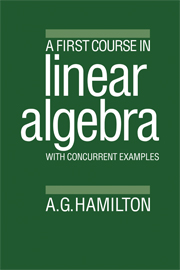Book contents
- Frontmatter
- Contents
- Preface
- 1 Gaussian elimination
- 2 Solutions to simultaneous equations 1
- 3 Matrices and algebraic vectors
- 4 Special matrices
- 5 Matrix inverses
- 6 Linear independence and rank
- 7 Determinants
- 8 Solutions to simultaneous equations 2
- 9 Vectors in geometry
- 10 Straight lines and planes
- 11 Cross product
- Answers to exercises
- Sample test papers
- Further reading
- Index
6 - Linear independence and rank
Published online by Cambridge University Press: 24 October 2009
- Frontmatter
- Contents
- Preface
- 1 Gaussian elimination
- 2 Solutions to simultaneous equations 1
- 3 Matrices and algebraic vectors
- 4 Special matrices
- 5 Matrix inverses
- 6 Linear independence and rank
- 7 Determinants
- 8 Solutions to simultaneous equations 2
- 9 Vectors in geometry
- 10 Straight lines and planes
- 11 Cross product
- Answers to exercises
- Sample test papers
- Further reading
- Index
Summary
Examples 6.1 illustrate what is meant by linear dependence of a list of vectors. More formally: given a list of vectors v1,…,vk of the same size (i.e. all are p × 1 matrices for the same p), a linear combination of these vectors is a sum of multiples of them, i.e. x1v1 + x2v2 + … + xkvk where x1, …, xk are any numbers. A list of vectors is said to be linearly dependent (abbreviated to LD) if there is some non-trivial linear combination of them which is equal to the zero vector. Of course, in a trivial way, we can always obtain the zero vector by taking all of the coefficients x1, …, xk to be 0. A non-trivial linear combination is one in which at least one of the coefficients is non-zero.
A list of vectors of the same size which is not linearly dependent is said to be linearly independent (abbreviated to LI).
Example 6.2 deals with the case of a list of two 2-vectors. A list of two non-zero 2-vectors is LD if and only if each is a multiple of the other. Example 6.3 deals with a list of three 2-vectors. Such a list is always LD. Why? Because a certain set of simultaneous equations must have a solution of a certain kind.
- Type
- Chapter
- Information
- A First Course in Linear AlgebraWith Concurrent Examples, pp. 55 - 64Publisher: Cambridge University PressPrint publication year: 1987



